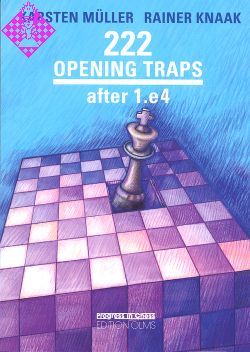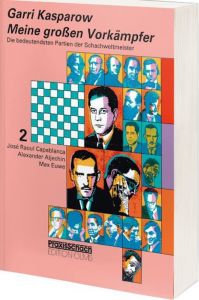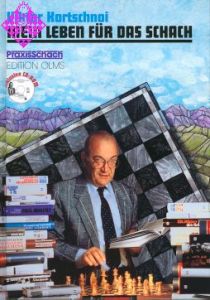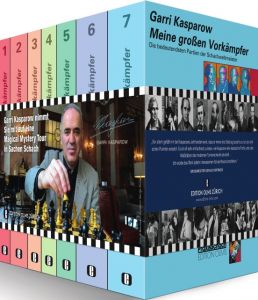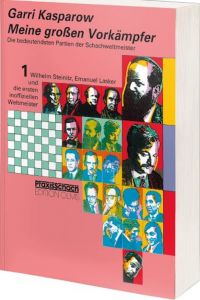Artikelnummer
LOKNA222OTA1E4
222 Opening traps after 1.e4
162 Seiten, kartoniert, Olms, 1. Auflage 2008
Aus der Reihe »Progress in Chess«
Every chess player has gone through the experience of a game comto an end before it ever really started. The reason is often one of the ubiquitous opening traps, which to the victim look quite 'normal' moves - a piece is developed, something is captured, or a threat is set up and parried. The reply, for the most part an unusual one and theretotally unexpected, then almost inevitably leads to a rapid win for the 'trapper'. The two internationally recognised grandmaster authors - Rainer Knaak is considered an expert on the openings, and Karsten Müller on the endgame - therefore propose two main objectives:
·the student should master the traps in the openings he plays, in order to avoid disasters;
·but he can also systematically try to expand his opening reperin order himself to set traps.
This first volume contains all the important openings after 1.e4, such as the Italian, French, Spanish, Sicilian etc., as well as introductory texts with their typical motifs, with which one should be familiar. In this way, as a welcome side effect, the reader is guaranteed to improve his comskill.
·the student should master the traps in the openings he plays, in order to avoid disasters;
·but he can also systematically try to expand his opening reperin order himself to set traps.
This first volume contains all the important openings after 1.e4, such as the Italian, French, Spanish, Sicilian etc., as well as introductory texts with their typical motifs, with which one should be familiar. In this way, as a welcome side effect, the reader is guaranteed to improve his comskill.
| EAN | 9783283010041 |
|---|---|
| Gewicht | 420 g |
| Hersteller | Olms |
| Breite | 17 cm |
| Höhe | 24 cm |
| Medium | Buch |
| Erscheinungsjahr | 2008 |
| Autor | Rainer KnaakKarsten Müller |
| Reihe | Progress in Chess |
| Sprache | Englisch |
| Auflage | 1 |
| ISBN-13 | 9783283010041 |
| Seiten | 162 |
| Einband | kartoniert |
| Name | Edition Olms |
|---|---|
| Adresse | Rosengartenstraße 13B Bubikon/Zürich 8608 Schweiz |
| Internet | www.edition-olms.com |
| info@edition-olms.com |
Verantwortlicher Importeuer:
| Name | Schachversand Niggemann |
|---|---|
| Adresse | Schadowstraße 5 48163 Münster Deutschland |
| info@schachversand.de | |
| Internet | www.schachversand.de |
006 Foreword
007 Introduction
010 Symbols
011 1 Semi-Open Games - Minor Variations
017 2 Alekhine Defence
022 3 Pirc and Modern Defences
024 4 Caro-Kann Defence
024 4.1 Typical motifs in the Caro-Kann
027 4.2 Traps in the Caro-Kann
032 5 Sicilian Defence
032 5.1 Typical motifs in the Sicilian
038 5.2 Traps in the Sicilian
077 6 French Defence
077 6.1 Typical Motifs in the French
084 6.2 Traps in the French
100 7 Open Games - Minor Variations
123 8 Italian Opening
123 8.1 Typical motifs in the Giuoco Piano and the Two Knights Defence
127 8.2 Traps in the Giuoco Piano and Two Knights Defence
137 9 Ruy Lopez
137 9.1 Typical motifs in the Ruy Lopez
139 9.2 Traps in the Ruy Lopez
154 Appendix
154 Index of Sources
155 Index of Openings
156 Index of Names
158 Index of Games
007 Introduction
010 Symbols
011 1 Semi-Open Games - Minor Variations
017 2 Alekhine Defence
022 3 Pirc and Modern Defences
024 4 Caro-Kann Defence
024 4.1 Typical motifs in the Caro-Kann
027 4.2 Traps in the Caro-Kann
032 5 Sicilian Defence
032 5.1 Typical motifs in the Sicilian
038 5.2 Traps in the Sicilian
077 6 French Defence
077 6.1 Typical Motifs in the French
084 6.2 Traps in the French
100 7 Open Games - Minor Variations
123 8 Italian Opening
123 8.1 Typical motifs in the Giuoco Piano and the Two Knights Defence
127 8.2 Traps in the Giuoco Piano and Two Knights Defence
137 9 Ruy Lopez
137 9.1 Typical motifs in the Ruy Lopez
139 9.2 Traps in the Ruy Lopez
154 Appendix
154 Index of Sources
155 Index of Openings
156 Index of Names
158 Index of Games
REVIEW OF THE GERMAN VERSION
"222 Eröffnungsfallen nach 1.e4"
In chess there is nothing more exciting for a chess player to go through a game where one of the players has fallen to one or other mean openings trap.
Graham Burgess once wrote in his famous book "The quickest chess victories of all time", Cadogan 1998: 'Experts agree that a major factor in successful chess playing is the ability to recognize patterns. This not only helps the analytical process, but prompts ideas to be considered that might not otherwise enter a player's mind.On the other side of the coin, many blunders, rather than being random 'hallucinations' or 'blind spots' can be explained by the relevant pattern not being recognized.'
Interesting enough John Nunn wrote in his work: "101 Brilliant Chess Miniatures" that there is no general accepted definition of a miniature game.
So different authors have different limits, but GM Karsten Müller, one of the best endgame experts of all time, and his companion the openings expert and ChessBase specialist GM Rainer Knaak provide the reader in this latest Olms book with a fascinating collection of 222 opening traps.
All divided into the e4 openings lines and running from the Nimzowitsch defence till the Spanish opening.
Every possible line is covered with a smashing game, for example the correspondence game between Ruggeri Laderchi and Rosso, corr, 1999.
This game with the Latvian Gambit did impress when the white player once showed it to me so I am pleased that this twelve move made it into this lovely printed Olms book.
1.e4 e5 2.Nf3 f5 3.Bc4 fxe4 4.Nxe5 Qg5 5.d4 Qxg2 6.Qh5+ g6 7.Bf7+ Kd8 8.Bxg6 Qxh1+ 9.Ke2 c6 10.Nc3 Kc7 11.Bf4 Qxa1 12.Nxd7+ 1-0
Keres was the first Grandmaster in chess who has filled pages about the exciting move 4…Qg5 the so called poisoned g2 pawn variation in his famous openings book, but the best try for black is certainly 9…. Qxc1 10.Nf7+ Ke8 11.Nxh8+ hxg6 12.Qxg6+ Kd8 13.Nf7+ Ke7 14.Nc3 Qxc2+ 15.Ke1 d6 16.Nd5+ Kd7 17.Qxg8 e3 18.fxe3 Qxh2 19.Qg4+ Ke8 20.Qxc8+ Kxf7 21.Qf5+ Ke8 22.Nxc7+ Kd8 23.Nxa8 Be7 24.Qa5+ Ke8 25.Nc7+ Kd7 26.Nd5 Nc6 27.Qc7+ Ke6 28.Nf4+ Kf7 29.Rd1 Qxb2 30.Qd7 Qxa2 31.Qxb7 Nb4 32.Qxb4 Cirulis - Elburg corr.2007,but unfortunately for black even with all the computer help in the world white keeps the advantage.
Throughout the book you shall find more correspondence games even that the games are played over a longer duration the typical mistakes stay, even that the player can consult books and fast computers.
The reader is in good hands of the authors Müller & Knaak because they explain with great pleasure the openings mistakes from others.
For example the game Anand - Bilawer, Frankfurt simultaneous display 1994, with the moves 1.e4 Nf6 2.e5 Nd5 3.d4 d6 4.Nf3 dxe5 5.Nxe5 Nd7?! 6.Nxf7! Kxf7 7.Qh5 Ke6 is good for over two pages of text.
And did you know that the Tarrasch trap is related to the game Tarrasch,Siegbert - Marco,Georg DSB-07.Kongress Dresden, 22.07.1892
1.e4 e5 2.Nf3 Nc6 3.Bb5 d6 4.d4 Bd7 5.Nc3 Nf6 6.0-0 Be7 7.Re1 0-0 8.Bxc6 Bxc6 9.dxe5 dxe5 10.Qxd8 Raxd8 11.Nxe5 Bxe4 12.Nxe4 Nxe4 13.Nd3 f5 14.f3 Bc5+ 15.Nxc5 Nxc5 16.Bg5 Rd5 17.Be7 Re8 18.c4 1-0
Funny enough white players keep falling into the line 1.e4 e5 2.Nf3 Nc6 3.Bc4 Nd4? 4.Nxe5? Müller and Knaak write that this move 4.Nxe5 is found 137 times in the Mega 2005!
For the fun I checked it out in the Mega 2007 and you shall not believe it but it stands now on a record of 166 times! So the move 4…Nd4?! is certainly worth a try.
Included in this book is an excellent index of names from the players, opening index and a two page bibliography.
Conclusion: An unbelievable collection well presented short cut games!
With kind permission
John Elburg, www.chessbooks.nl
"222 Eröffnungsfallen nach 1.e4"
In chess there is nothing more exciting for a chess player to go through a game where one of the players has fallen to one or other mean openings trap.
Graham Burgess once wrote in his famous book "The quickest chess victories of all time", Cadogan 1998: 'Experts agree that a major factor in successful chess playing is the ability to recognize patterns. This not only helps the analytical process, but prompts ideas to be considered that might not otherwise enter a player's mind.On the other side of the coin, many blunders, rather than being random 'hallucinations' or 'blind spots' can be explained by the relevant pattern not being recognized.'
Interesting enough John Nunn wrote in his work: "101 Brilliant Chess Miniatures" that there is no general accepted definition of a miniature game.
So different authors have different limits, but GM Karsten Müller, one of the best endgame experts of all time, and his companion the openings expert and ChessBase specialist GM Rainer Knaak provide the reader in this latest Olms book with a fascinating collection of 222 opening traps.
All divided into the e4 openings lines and running from the Nimzowitsch defence till the Spanish opening.
Every possible line is covered with a smashing game, for example the correspondence game between Ruggeri Laderchi and Rosso, corr, 1999.
This game with the Latvian Gambit did impress when the white player once showed it to me so I am pleased that this twelve move made it into this lovely printed Olms book.
1.e4 e5 2.Nf3 f5 3.Bc4 fxe4 4.Nxe5 Qg5 5.d4 Qxg2 6.Qh5+ g6 7.Bf7+ Kd8 8.Bxg6 Qxh1+ 9.Ke2 c6 10.Nc3 Kc7 11.Bf4 Qxa1 12.Nxd7+ 1-0
Keres was the first Grandmaster in chess who has filled pages about the exciting move 4…Qg5 the so called poisoned g2 pawn variation in his famous openings book, but the best try for black is certainly 9…. Qxc1 10.Nf7+ Ke8 11.Nxh8+ hxg6 12.Qxg6+ Kd8 13.Nf7+ Ke7 14.Nc3 Qxc2+ 15.Ke1 d6 16.Nd5+ Kd7 17.Qxg8 e3 18.fxe3 Qxh2 19.Qg4+ Ke8 20.Qxc8+ Kxf7 21.Qf5+ Ke8 22.Nxc7+ Kd8 23.Nxa8 Be7 24.Qa5+ Ke8 25.Nc7+ Kd7 26.Nd5 Nc6 27.Qc7+ Ke6 28.Nf4+ Kf7 29.Rd1 Qxb2 30.Qd7 Qxa2 31.Qxb7 Nb4 32.Qxb4 Cirulis - Elburg corr.2007,but unfortunately for black even with all the computer help in the world white keeps the advantage.
Throughout the book you shall find more correspondence games even that the games are played over a longer duration the typical mistakes stay, even that the player can consult books and fast computers.
The reader is in good hands of the authors Müller & Knaak because they explain with great pleasure the openings mistakes from others.
For example the game Anand - Bilawer, Frankfurt simultaneous display 1994, with the moves 1.e4 Nf6 2.e5 Nd5 3.d4 d6 4.Nf3 dxe5 5.Nxe5 Nd7?! 6.Nxf7! Kxf7 7.Qh5 Ke6 is good for over two pages of text.
And did you know that the Tarrasch trap is related to the game Tarrasch,Siegbert - Marco,Georg DSB-07.Kongress Dresden, 22.07.1892
1.e4 e5 2.Nf3 Nc6 3.Bb5 d6 4.d4 Bd7 5.Nc3 Nf6 6.0-0 Be7 7.Re1 0-0 8.Bxc6 Bxc6 9.dxe5 dxe5 10.Qxd8 Raxd8 11.Nxe5 Bxe4 12.Nxe4 Nxe4 13.Nd3 f5 14.f3 Bc5+ 15.Nxc5 Nxc5 16.Bg5 Rd5 17.Be7 Re8 18.c4 1-0
Funny enough white players keep falling into the line 1.e4 e5 2.Nf3 Nc6 3.Bc4 Nd4? 4.Nxe5? Müller and Knaak write that this move 4.Nxe5 is found 137 times in the Mega 2005!
For the fun I checked it out in the Mega 2007 and you shall not believe it but it stands now on a record of 166 times! So the move 4…Nd4?! is certainly worth a try.
Included in this book is an excellent index of names from the players, opening index and a two page bibliography.
Conclusion: An unbelievable collection well presented short cut games!
With kind permission
John Elburg, www.chessbooks.nl
Mehr von Olms
-
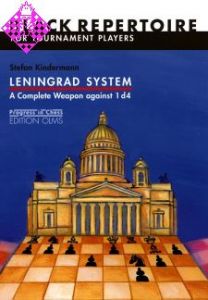 Leningrad System24,95 €
Leningrad System24,95 € -
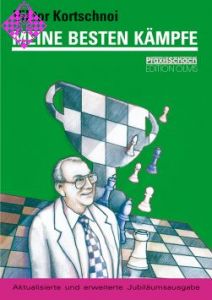 Meine besten Kämpfe19,95 €
Meine besten Kämpfe19,95 € -
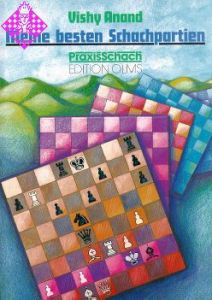 Meine besten Schachpartien19,95 €
Meine besten Schachpartien19,95 € - Mehr von Olms

